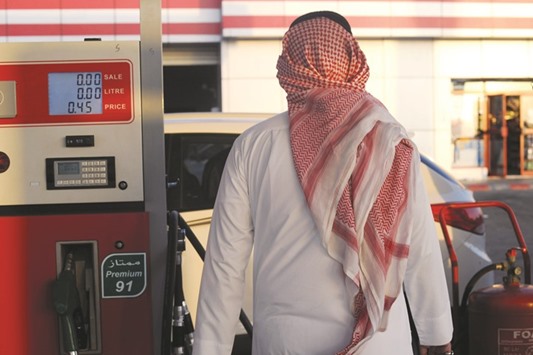Saudi Arabia’s decision to reduce energy subsidies will lead to higher fuel prices and limit growth in the country’s consumption of oil in 2016, according to the International Energy Agency. Similar cuts by other Gulf Arab states will further squeeze demand growth in the Persian Gulf region.
“Already forecast to see decelerating demand growth in 2016, higher prices will inevitably further dent the Saudi Arabian oil demand outlook,” the IEA said yesterday in its monthly report.
Saudi Arabia announced plans in December to cut spending and said it might tap local and international debt markets this year to fund a deficit after the 35% plunge in oil prices last year eroded state income. The kingdom said it expects to sell stakes in some state-owned entities, including Saudi Arabian Oil Co, the world’s biggest crude exporter, known as Aramco. It also took the unprecedented step of reducing fuel subsidies, raising retail gasoline prices by about 50%.
Year-on-year growth in Saudi gasoline consumption neared a three-year high in October, before the cuts, according to the most recent official figures from the Joint Organisations Data Initiative.
Saudi oil demand is forecast to rise by just 45,000 bpd to 3.3mn bpd in 2016, sharply lower than the 125,000-bpd expansion in 2015, the IEA said. Subsidy cuts by Bahrain, Oman and the UAE will add to the impact on Middle Eastern oil demand, which will gain by only 100,000 bpd to 8.3mn bpd, it said.
As of January 11, gasoline prices in Saudi Arabia rose to 0.75 riyals (20 cents) per liter from 0.45 riyals per liter for 91- octane fuel, and 0.9 riyals per liter from 0.6 riyals per liter for 95-octane grade, said the IEA, a watchdog agency for the world’s most industrialised countries.
Natural gas, ethane, diesel, kerosene, electricity and water prices are also subject to price increases as part of the government’s five-year plan to reduce subsidies, according to the agency. Ethane prices will rise by 133%, transport diesel by 79%, industrial diesel by 55% and kerosene by 12%, it said.
“Higher oil product prices potentially curb already precarious economic growth as costs for industry increase,” the IEA said.
Saudi Arabia Basic Industries Corp, known as Sabic, said its cost of doing business will rise by more than 5% due to the 2016 Saudi budget, the IEA said. Yanbu National Petrochemical Co and Saudi Arabian Fertilizer Co see costs rising respectively by 6.5% and 8%, it said.
“The net long-term impact for Saudi Arabia is likely to be positive as government balances improve and resource allocations become less distorted,” the IEA said.
Saudi prices for gasoline remain “exceptionally cheap in international terms,” equating to roughly one-sixth those in the UK, one-fourth those in China and half those in Iran, it said.

A Saudi man walks past a pump at a petrol station in Jeddah. Saudi oil demand is forecast to rise by just 45,000 bpd to 3.3mn bpd in 2016, sharply lower than the 125,000-bpd gain in 2015, the IEA said.


